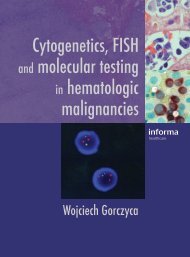Color Atlas of Hematology - Practical Microscopic and Clinical ...
Color Atlas of Hematology - Practical Microscopic and Clinical ...
Color Atlas of Hematology - Practical Microscopic and Clinical ...
- No tags were found...
Create successful ePaper yourself
Turn your PDF publications into a flip-book with our unique Google optimized e-Paper software.
68Abnormalities <strong>of</strong> the White Cell SeriesExamples <strong>of</strong> Extreme Lymphocytic Stimulation:Infectious MononucleosisEpstein–Barr virus infection should be considered when, after a prodromalfever <strong>of</strong> unknown origin, there are signs <strong>of</strong> enlarged lymph nodes <strong>and</strong>developing angina, <strong>and</strong> the blood analysis shows predominantly mononuclearcells <strong>and</strong> a slightly, or moderately, elevated leukocyte count. Varyingproportions <strong>of</strong> the mononuclear cells (at least 20%) may be rather extensivelytransformed round cells (Pfeiffer cells, virocytes). Immunologicalmarkers are necessary to ascertain that these are stimulated lymphocytes(mostly T-lymphocytes) defending the B-lymphocyte stem populationagainst the virus attack. The nuclei <strong>of</strong> these stimulated lymphocytes aretwo- to three-fold larger than those <strong>of</strong> normal lymphocytes <strong>and</strong> theirchromatin has changed from a dense <strong>and</strong> coarse structure to a looser,more irregular organization. The cytoplasm is always relatively wide <strong>and</strong>more or less basophilic with vacuoles. Granules are absent. A small proportion<strong>of</strong> cells appear plasmacytoid. In the course <strong>of</strong> the disease, thedegree <strong>of</strong> transformation <strong>and</strong> the proportions <strong>of</strong> the different cell morphologieschange almost daily. A slight left shift <strong>and</strong> elevated monocytecount are <strong>of</strong>ten found in the granulocyte series.Acute leukemia is <strong>of</strong>ten considered in the differential diagnosis in additionto other viral conditions, because the transformed lymphocytes canresemble the blasts found in leukemia. Absence <strong>of</strong> a quantitative reduction<strong>of</strong> hematopoiesis in all the blood cell series, however, makes leukemiaunlikely, as do the variety <strong>and</strong> speed <strong>of</strong> change in the cell morphology. Finally,serological tests (EBV antigen test, test for antibodies, <strong>and</strong>, if indicated,quick tests) can add clarification.Where serological tests are negative, the cause <strong>of</strong> the symptoms is usuallycytomegalovirus rather than EBV.Characteristics <strong>of</strong> Infectious MononucleosisAge <strong>of</strong> onset: School age<strong>Clinical</strong> findings: Enlarged lymph nodes (rapid onset), inflammations<strong>of</strong> throat <strong>and</strong> possibly spleen CBC: Leukocytes , stimulated lymph nodes, partially lymphoblasts(hematocrit <strong>and</strong> thrombocytes are normal)Further diagnostics: EBV serological test (IgM +), transaminases usuallyDifferential diagnosis: Lymphomas (usually without fever), leukemia(usually Hb , thrombocytes ) Persistent disease (more than 3weeks): possibly test for blood cell markers, lymph node cytology( histology)Course, treatment: Spontaneous recovery within 2–4 weeks; generalpalliation






